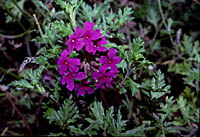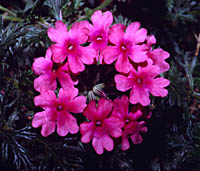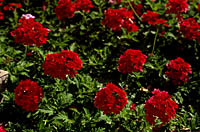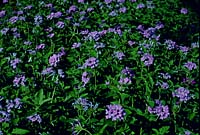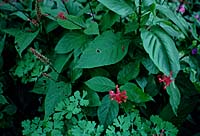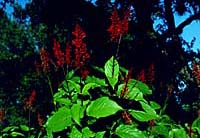
1. Blue Princess Verbena (Verbena X Hybrida 'Blue Princess')
2. The San Antonio Garden Center SaleSpreading perennial with showy lavender-blue flowers. Discovered in England by Greg Grant, formerly of Color Spot, now teaching at Stephen F. Austin. Zone 8.
One of the showiest of perennial flowers is the verbena. Verbena has many attributes such as heat tolerance, everblooming and enduring. However, since nothing is perfect, verbena has some faults which, if known in advance, can be avoided. Remembering that "a word to the wise is sufficient", I will concentrate on the faults of verbena so you can know how to successfully grow one of Texas' most adapted plants.
The first, and probably most significant, Verbena problem is knowing how to identify the best of the Verbena types. In 1985 Extension horticulturists began to clarify Verbena nomenclature. Verbena types available are the short-lived annual verbena (Verbena hortensis); the large-flowered, short-lived perennial verbena (sometimes referred to the species V. x hybrida types); and the smaller-flowered but long-lived perennial verbena loosely referred to by botanists as Verbena Hybrids (Verbena x tenera). Throughout the years local horticulturists have noticed that a particular form of the last classification of Verbena Hybrids are among the easiest of the verbena to grow and would normally be perennial unless exposed to a wet spring or fall when the foliage is susceptible to attacks of the fungus called powdery mildew. To clearly identify this superior Verbena for garden consumers was a major problem. The adapted Verbena was called by many names such as common verbena (there were at least three types called verbena!), sand verbena and vervain. The most adapted Verbena did not have a common name which could be agreed upon by the numerous botanists consulted because this Verbena is a hybrid (mixture of species). Regardless of its true identity, all agree that it is a tough, Texas plant which should be planted in this area by those who enjoy beautiful bloom in the heat of summer. To plainly identify this Verbena, it was given the name TexTuf. TexTuf verbena is available in three colors -- purple, pink and red. The true TexTuf Verbena has a label in each group of plants clearly identifying it as the selected type. Otherwise, the buyer has to be familiar with the plant-type to know it is the long-lasting Verbena.
The second problem with Verbena is planting location and culture. Most people make the mistake of pampering it. It MUST be planted in the sunniest, best drained spot in your landscape. It WILL NOT bloom profusely, and, in fact, becomes diseased with powdery mildew unless the plants get plenty of sunlight (8-10 hours of direct, sunbathing sunlight). Verbenas do not require a particularly rich soil but periodic (at least monthly) applications of a slow-release, complete fertilizer such as 19-5-9 at the Rate of one pound per 100 square feet are beneficial during the growing season. In the case of plants which have borne an abundance of bloom and then show signs of going out of bloom, a light pruning will produce another crop of flowers within 15-20 days. Here's the problem; people DO NOT want to cut plants back and WILL NOT cut them back as long as one pitiful-looking bloom endures. People who cannot discipline themselves to shear old blooms periodically should not grow Verbena. After the first spectacular bloom display cut-shy people will be looking at ugly for the rest of the season and wondering why. Bloom removal is not tedious. Simply trim about a fourth of the plant's top growth, including old flowers but do not expose main stems, with a flexible line trimmer. Pruning removes old flower parts, shortens the plants and encourages branching which soon results in an even showier and prolonged display of bloom especially if you will fertilize and water after each cutback. Cutback will probably be required two or three times per season. The final, most drastic cutback will be in the fall when plants are cutback so winter annuals such as pansies, dianthus or bluebonnets can the interplanted among the Verbena.
The third problem with Verbena is that they are susceptible a few to pests. Well, so is every other living thing! I mentioned that Verbena is susceptible to the fungus powdery mildew if planted in a wet, shady locale. If the plant is neglected (not fertilized and watered properly) it is likely to become infested with spider mites, a common Texas nemesis. Miticide such as Kelthane (Red Spider Mite Spray) with two teaspoons of liquid detergent added per gallon of spray applied every 5 days for four consecutive sprays will help. Organic growers can use insecticidal soaps or sulfur dust but an invasion of spider mites MUST be dealt with or plants can be destroyed. Leaf miners which make little trails in the leaves do not cause significant damage but are ever-present. Systemic insecticides such as Isotox, disyston (Systemic Insecticide), and cygon can be used periodically for longer lasting insect control. Thrips and leaf hoppers can also be a problem and can be controlled with the same insecticides.
The three problems which I mention, just to make you aware, SHOULD NOT distract gardeners from using one of the few summer perennials which can survive and beautify the Texas summers (which are usually hotter than Hades!) If you have a sunny, well-drained location and are willing to shear Verbenas periodically, I will make three recommendations:
- Any of the TEXTUF SERIES -- purple, pink and red
Purple Pink Red
- A beautiful lavender blue Verbena from England named BLUE PRINCESS VERBENA(Verbena x hybrida 'Blue Princess'). It is a rapidly spreading perennial Verbena with showy lavender-blue flowers. This variety was discovered in England by Greg Grant, former Bexar County Extension Horticulturist, while on a plant collecting trip to England for Color Spot Growers. Color Spot has graciously made this new, blue verbena available to everyone.
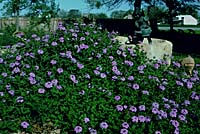
Verbena is described as "a genus of perennial herbs (sometimes known by the ancient name Vervain)". Verbenas have been known since the most ancient times. The druids had the greatest veneration for the plant, and before gathering it offered a sacrifice to the soil. They also held bunches of verbena between their hands during their devotions. When the Romans sent messengers of peace to other nations they adorned their apparel with sprays of verbena. Images of Venus Victrix were often crowned with wreaths of verbena and myrtle. The peoples of Antiquity also attributed verbenas with certain medicinal properties. It was noted that much of the fame attached to the plants was mainly attributable to magical practices performed with the herbs. The Romans credited powers of rekindling the flames of dying love to the plant, and gave it the name Herba Veneris (plant of Venus). During the Middle Ages and the Renaissance, it became an instrumental component in the rites of witches and sorcerers. In folk medicine, a decoction of verbena leaves boiled in vinegar was used to treat rheumatic pains, lumbago, and pleurisy. It also provided a potion for aiding digestion. The flowering tips of young growth and the leaves of Verbena officinalis dried in the sun contain the glucoside verbenaline which, if incorrectly used, can cause paralysis. All of the Verbena which I have previously mentioned are crosses of several species and not intended for herbal use. I just though since some people enjoy saying they are growing "herbs", Verbena fits right into the herb category. Besides, Verbena is a beautiful blooming herb which will tolerate all that a hot Texas summer has to offer.
Funds will be used to support GardenCenter activities. Plants will be promoted and advertised in San Antoniomedia but not necessarily available in local nurseries
- Fiesta (variegated green-and-white foliage) Turk's Cap (Malvaviscus arboreus) is a shade-tolerant, deer-resistant Texas native that has blooms which hummingbirds love. Grows in sun or part sun. Grows 4 to 5 feet tall, forming a shrub like perennial plant. Flowers from late spring through the fall, with bright red petals rolled loosely around the flowers' reproductive parts. It is a relative of hibiscus, with variegated green-and-white foliage which makes a perfect complement to colorful flowers and is a showy stand-out in shady areas where the green color is lost. Hummingbirds love it and enjoy feeding in the shade. It dies to the ground each winter, then comes back in the spring -- it is a root-hardy perennial. It is an old-time favorite of early Texas gardeners since it is deer resistant as well. It is drought tolerant and some have indicated that plants can be weeded with a glyphosate herbicide such as Roundup, Kleanup or Finale without significant, if any, damage to the foliage of the Turk's Cap. (Try at your own risk!!)
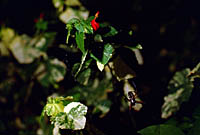
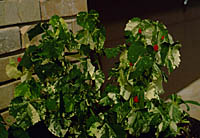
- The Firespike is a plant which solves the problem of most landscaperswho have a shady area in which very few plants will grow, much less bloom. Firespike will not only grow in the shade but plants will provide a magnificent display of practically glow-in-the-dark red bloom spikes which attract hummingbirds and butterflies.
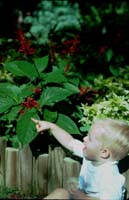
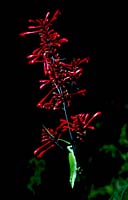
Firespike (Odontonema strictum) is a shade loving, tender perennial with deep green, glossy leaves. It will be grown for its beautiful foliage in the spring and summer. Firespike is a substitute for the nationwide popular hosta which is devoured by snails in this area of Texas. This beautiful foliage provides a startling contrast to its fire-red late season blooms. Its brilliant spikes of deep red flowers in late summer and fall are cherished by hummingbirds and butterflies. Firespike can be grown as a tropical container plant, an annual which grows about 2 feet the first season, or, if it survives the winter as a protected perennial growing more than 4 feet tall. This plant can be grown in heavy clay soils and wet conditions. A recommendation by some is that some of these plants be dug and potted in late fall and used as blooming house plants throughoutthe winter. It is one of the most versatile plants and definitely the best blooming plants for shade conditions.
- Any plant material still available from the Rodeo Sale in February.
| Return to Index | Go to April |
